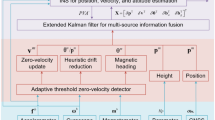Abstract
GPS satellite positioning is currently a system used by people for navigation. As urban buildings become larger and their internal usages more diverse, the internal structure of the buildings turns into complex. Indoor positioning with GPS is often blocked by buildings, so that GPS is unable to accurately locate a user’s position inside buildings. Currently, dead reckoning techniques can improve this issue in indoor positioning. However, the techniques need the deployment of many sensing devices in indoor environment, and the estimated distance would still result in serious errors. In this situation, it leads to the high cost of labor, materials, and equipment. In this study, we develop a gait recognition and counting scheme based on a self-made sensor to collect spatial data and user walks. The scheme can accurately calculate the number of walking steps, and then calculate the distance by effectively reducing the distance error.
Access this chapter
Tax calculation will be finalised at checkout
Purchases are for personal use only
Similar content being viewed by others
References
Hightower, J., Borriello, G.: Location systems for ubiquitous computing. Computer 34(8), 57–66 (2001)
Liu, H., Darabi, H., Banerjee, P., Liu, J.: Survey of wireless indoor positioning techniques and systems. IEEE Trans. Syst. Man Cybern. C Appl. Rev. 37(6), 1067–1080 (2007)
Challamel, R., Tome, P., Harmer, D., Beauregard, S.: Performance assessment of indoor location technologies. In: Proceedings of the IEEE/ION Position, Location Navigation Symposium, pp. 624–632 (2008)
Ladetto, Q., Gabaglio, V., Merminod, B., Terrier, P., Schutz, Y.: Human walking analysis assisted by DGPS, pp. 1–4. GNSS, Edinburgh (2000)
Ladetto, Q.: On foot navigation: continuous step calibration using both complementary recursive prediction and adaptive Kalman filtering. In: Proceedings of the ION GPS, pp. 1735–1740 (2000)
Ladetto, Q., Merminod, B.: An alternative approach to vision techniques: Pedestrian navigation system based on digital magnetic compass and gyroscope integration. In: Proceedings of the 6th World Multiconference on Systemics, Cybernetics (2002)
Mezentsev, O., Collin, J., Lachapelle, G.: Pedestrian dead reckoning—a solution to navigation in GPS signal degraded areas? Geomatica 59(2), 175–182 (2005)
Fang, L.: Design of a wireless assisted pedestrian dead reckoning system—the NavMote experience. IEEE Trans. Instrum. Meas. 54(6), 2342–2358 (2005)
Judd, T.: A personal dead reckoning module. In: Proceedings of the ION GPS, vol. 97, pp. 47–51 (1997)
Jirawimut, R., Ptasinski, P., Garaj, V., Cecelja, F., Balachandran, W.: A method for dead reckoning parameter correction in pedestrian navigation system. IEEE Trans. Instrum. Meas. 52(1), 209–215 (2003)
Neumann, D.: Kinesiology of the Musculoskeletal System: Foundations for Rehabilitation, 2nd edn. Elsevier, Health Sciences, Amsterdam (2013). ISBN 0323266320
Magee, D.: Orthopedic Physical Assessment, 6th edn. Elsevier, Health Sciences, Amsterdam (2014). ISBN 1455709751
Acknowledgements
This work was financially supported by the “Intelligent Recognition Industry Service Center” from The Featured Areas Research Center Program within the framework of the Higher Education Sprout Project by the Ministry of Education (MOE) in Taiwan. Simultaneously, the authors are also grateful to the MOST, Taiwan, for supporting this study under the contracts MOST 107-2637-E-224-004.
Author information
Authors and Affiliations
Corresponding author
Editor information
Editors and Affiliations
Rights and permissions
Copyright information
© 2019 Springer Nature Singapore Pte Ltd.
About this paper
Cite this paper
Chang, T. et al. (2019). Indoor Navigation Based on a Gait Recognition and Counting Scheme. In: Chang, CY., Lin, CC., Lin, HH. (eds) New Trends in Computer Technologies and Applications. ICS 2018. Communications in Computer and Information Science, vol 1013. Springer, Singapore. https://doi.org/10.1007/978-981-13-9190-3_43
Download citation
DOI: https://doi.org/10.1007/978-981-13-9190-3_43
Published:
Publisher Name: Springer, Singapore
Print ISBN: 978-981-13-9189-7
Online ISBN: 978-981-13-9190-3
eBook Packages: Computer ScienceComputer Science (R0)




